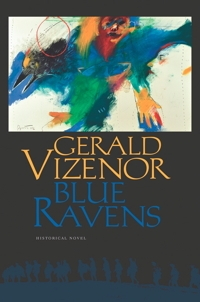Blue Ravens
Characters intrigue and danger incites emotion as two Native American brothers navigate the effects of World War I.
The bitter legacy of World War I included hundreds of thousands of casualties of poison gas, bullets, and influenza. Those who survived, including the two main characters of this novel—Basile Hudson Beaulieu, the narrator and a writer, and Aloysius, Basile’s brother and an artist known for his paintings and carvings of totemic blue ravens—endured physical wounds and post-traumatic stress disorder that tormented them for the rest of their lives. This richly detailed account (one that reflects much of author Gerald Vizenor’s own life) follows both men from the time they are young boys and members of the Anishinaabe people, called the Chippewa by Euro-Americans, living on the White Earth Reservation of Minnesota, through their service as scouts in the war, and their lives as expatriates in Paris seeking a better life.
Vizenor is the acclaimed and prolific author of forty books, including an American Book Award-winning novel. The author skillfully employs Native American traditions, including trickster tales, irony, nonlinear time, and a sense of presence in which the past, present, and future are fused. Vizenor’s excellent character development and lively dialogue more than compensate for the few times the novel’s pace slows.
Interesting characters who exemplify the Native literary conventions include Odysseus Walker Young, a peddler, admired by Native Americans for his honesty, who exuberantly displays a trickster’s skills; Misaabe, who practices natural medicine and travels with a pack of healing dogs; and Foamy, the none-too-bright station agent who hates the inhabitants of the White Earth Reservation and their customs. Together these characters provide welcome breaks from the tension and danger that drive the book.
The most powerful and graphic stories tell of the brothers’ service as scouts in the American Expeditionary Force in France during the bloody 1918 Battle of Argonne and Meuse Offensive, in which 26,000 Americans were killed in six weeks. Basile and Aloysius barely escape from being included among these fatalities. After the war, the brothers return to the reservation but cannot remain where they have again become captives. Horrible recurring images of carnage prevent them from hunting, as the thought of killing, even for food, revolts them.
Readers of this emotionally wrought, finely crafted historical novel will likely feel a sense of satisfaction from meeting fascinating people and learning much about the Anishinaabe. But they will also be left in melancholy knowing that not much has changed about reservation life during the last century.
Reviewed by
Karl Helicher
Disclosure: This article is not an endorsement, but a review. The publisher of this book provided free copies of the book to have their book reviewed by a professional reviewer. No fee was paid by the publisher for this review. Foreword Reviews only recommends books that we love. Foreword Magazine, Inc. is disclosing this in accordance with the Federal Trade Commission’s 16 CFR, Part 255.

